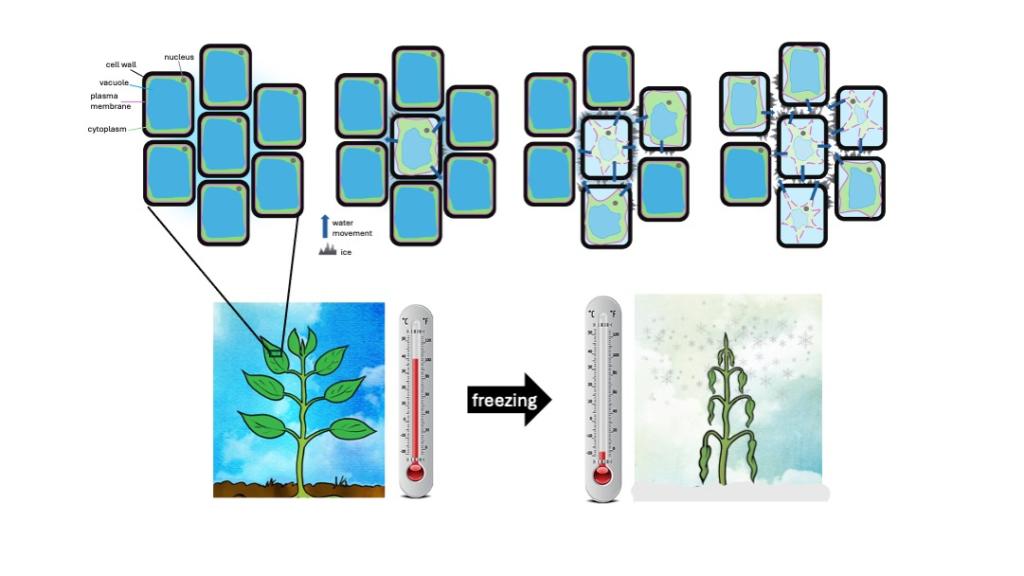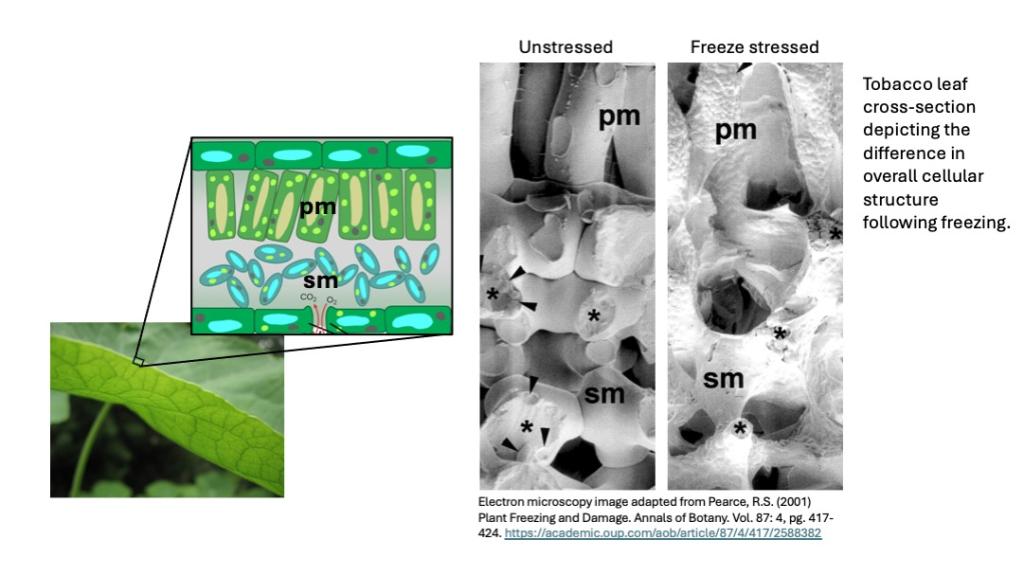Even with spring quickly overtaking winter in the Mid-Atlantic, many gardeners are still monitoring frost dates. An unexpected late freeze could have detrimental effects on spring plantings. Freezing temperatures present a specific set of challenges to flora that can only be understood when seen at the cellular level. It can cause damage or fully kill a plant. So what happens to a plant’s cells when the temperature falls below freezing?
In non-freezing and well-watered conditions, plant cells are full of (and surrounded by) water. This water keeps the cells plump, which consequently keeps your plant perky. As the temperature drops and freezing begins, the water outside the cells begins to freeze first. The liquid inside the cell contains more metabolites, soluble sugars, and other solutes important for maintaining plant life which makes it freeze at lower temperatures than the fluid on outside of it. This is similar to how saltwater requires a lower temperature to freeze than fresh water.

As the more dilute extracellular water freezes, it forms ice crystals between the cells which causes them to deform. But the biggest issue is when the water inside the cell floods outward to maintain the balance of water on either side of the membrane, effectively dehydrating the cell. If we remember back to biology class, water moves across cellular membranes along its concentration gradient, seeking to keep the amount of water balanced on both sides of the membrane.
Once the extracellular water freezes, it becomes locked away in ice, unavailable for the plant to use. The water inside the cell rushes across the membrane to rectify the imbalance. As water leaves the cell, it shrinks. Shrinking cells is what causes a plant to wilt.
Making the situation worse, membranes are permeable to water but not to the metabolites inside the cell (at least not without some help), so the water moving outside the cell is diluted when it reaches the extracellular space. This diluted water then freezes, exacerbating the problem as more and more cells are dehydrated. If the cell stays dehydrated for too long the cellular membrane will be permanently damaged causing holes to form, the cellular contents to spill out, and the cell to die. As more cells die, the likelihood of the plant recovering decreases.

Adapting to the freeze
But plants have evolved several ways to protect themselves against the perils of freezing, and some are better than others. This is the basis behind the USDA plant hardiness zone map. How well a plant fares during a freeze depends on what environment the plant is adapted to (which is usually best near where it evolved). You can check the USDA plant hardiness zone map to see where a particular plant can survive the winter.
When temperatures begin to drop, many plants will gradually ramp down photosynthesis and other metabolic activities (called dormancy) to conserve resources and water. For deciduous plants, this coincides with their leaves changing color and eventually dropping. By shedding their leaves, the plant protects against water loss, since most water is lost through pores in the leaves called stomata. Plants can also lower their freezing point by increasing the metabolite content in their cells.
Many of the cellular changes during cold acclimation have more to do with tolerating ice rather than preventing ice from forming. Many winter hardy plants change the composition of their cellular membrane so it is better able to withstand deformation and quick changes in volume, similar to making a balloon even stretchier so it can inflate and deflate without busting.
Depending on whether the plant has the capability (or more notably the time) to properly acclimatize or “harden” prior to winter) largely determines how much damage a freeze will cause. Both cold acclimation in the fall and de-acclimation in the spring are very gradual processes and a surprise freeze at the wrong time could wreak havoc on even the hardiest plants.
There are also some things you can do to protect your plants against freeze damage. First, make sure they are well watered before a freeze. Moist soil is warmer than dry soil, and water availability could help mitigate the impending dehydration when ice forms. Second, adding a layer of mulch around the base of the plant traps air near the roots to create an insulating effect, and minimizes water loss.
Additionally, some advise leaving snow on leaves (as long as it doesn’t break branches under the weight) so it will melt gradually and keep the leaves moist while insulating them against the cold, dry outside air.
In the next blog post, we’ll dive into the recent updates and changes to the USDA plant hardiness zone map!
References:
https://academic.oup.com/plphys/article/118/1/1/6085571
https://academic.oup.com/aob/article/87/4/417/2588382
—---
Destiny Davis is AAAS Science and Technology Policy Fellow at the U.S. Botanic Garden.